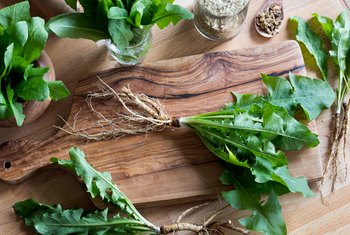Welcome! This article begins my series entitled Wild Herbs 101. These are herbs commonly found in the wild here in North Eastern US that are easy to identify, harvest, and use. I'm going to avoid herbs that have cautions or that are difficult to identify correctly.
The first wild herb is a well-known one, commonly referred to as a weed and often covered by herbalists. The common
Dandelion! It's Latin name is
Taraxacum officinale and it belongs to the largely global flower family called
Asteraceae. The nickname dandelion comes from the French language and means "lion's tooth", referring to the pointy petals.
Identification & Habitat
Dandelions are easily identified by their bright yellow single flower heads, or florets, per stalk growing from a radial central leaf rosette. The leaves are toothed and the long tap roots with milky sap make dandelions easy to identify. Dandelions colonize lawns, gravel, sidewalks, fields, and urban areas easily. The flowers are attractive to all kinds of pollinators! Once the bloom has been pollinated, a round seed head forms and the seeds are carried away by wind or foot traffic.
Harvesting
When harvesting , it's important to consider the environment in which they are growing. If you plan to use dandelions medicinally or for culinary recipes, only harvest from areas that have minimal to no chemicals or urban dust. Dandelions can be harvested for their leaves, blossoms, or roots. Stems and seeds are typically not consumed. However this fellow was able to extract some oil from the seeds as well as grow them for edible microgreens!
Bring a clean, sharp knife and
a reusable bag or container to harvest. Harvest in the morning, before the heat of the sun has wilted the plants, and bring your harvest home & prepare quickly to preserve the integrity of the plant. Wash dandelions on cool water, being careful to remove debris and insects, and lay to dry on a towel.
Health Benefits & Uses
Dandelion is an amazing, easily accessible and considerably safe herb for beginners! "It is restorative and rejuvenating, and particularly helps with blood, kidney and liver functions. It is also a bitter that helps with digestion and bile flow. It supports healthy water elimination without compromising potassium reserves. Dandelion is also high in vitamins and minerals like calcium, magnesium, iron, and vitamins A and C."
*
The uses for dandelions are many: teas,
tinctures, salves, alcohols, salads, baking, and more. "Dandelion greens come from the leaves of the dandelion and can be steamed, sautéed or even eaten raw. They have an earthy, bitter taste that can complement a variety of dishes.
Dandelion root, on the other hand, is often powdered and roasted for use as a coffee substitute or added raw to herbal teas."
*
For the sweetest possible products, harvest the newest leaves and blossoms in the mornings, after a rain, or in spring. For the strongest dandelion recipes, or for medicinal purposed, harvest the roots in fall.* Listed below are some uses and recipes links for each part of the dandelion plant.
Dandelion Flowers:
As with any herb, moderation and smart usage is key. It's never recommended - no matter how safe the herb - to start eating pounds of a new plant per week! However, smart supplementation, such as substituting dandelion greens for spinach in recipes, making some dandelion blossom or root tea for liver/kidney/gastrointestinal health, or brewing some dandelion blossom alcohol to enjoy occasionally is perfect. Have fun, harvest some dandelions & enjoy the health benefits of this fascinating common herb!










Comments
Post a Comment